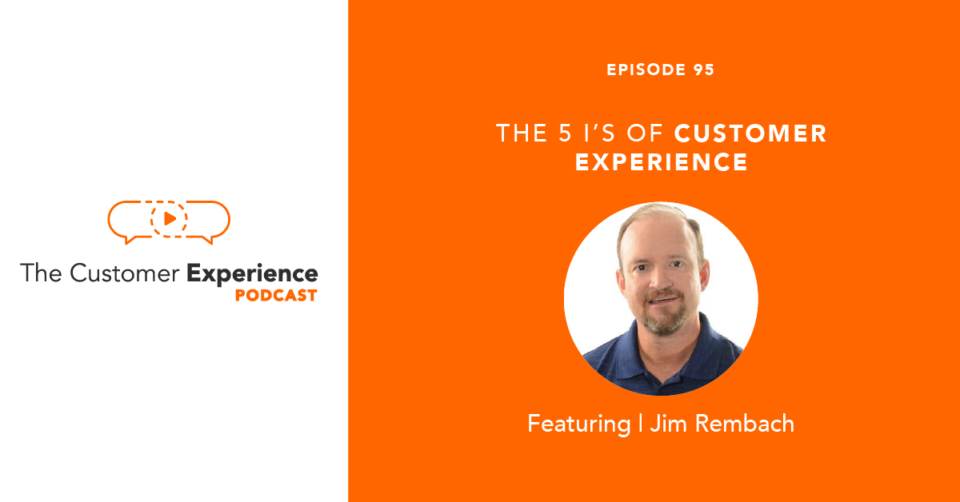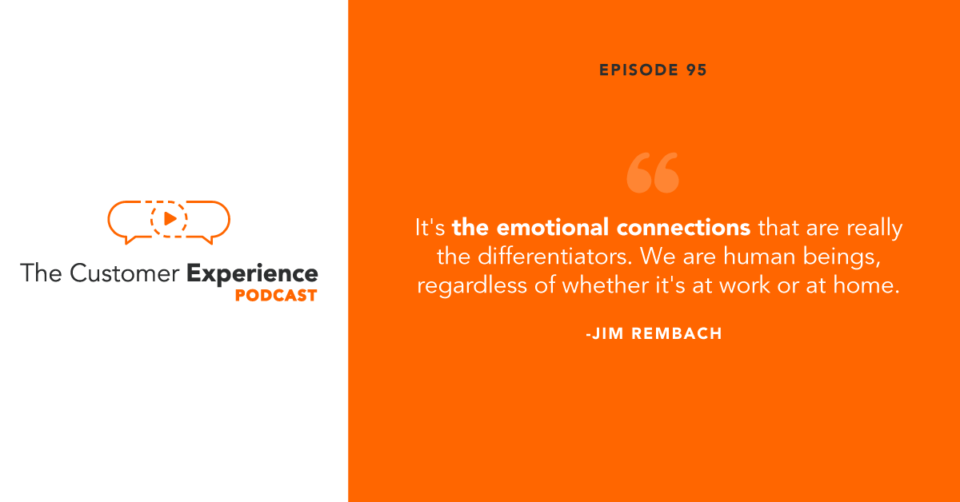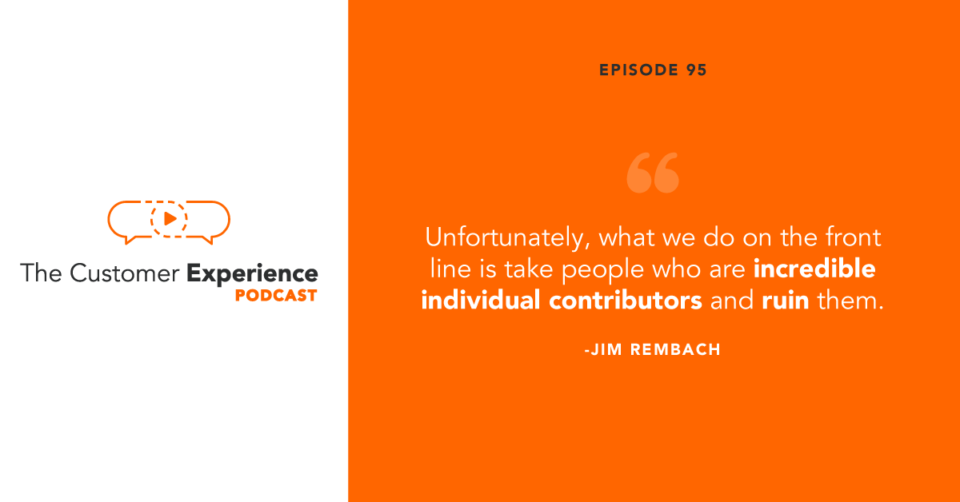
Listen to “95. The 5 I’s of Customer Experience w/ Jim Rembach” on Spreaker.
Apple Podcasts | Google Podcasts | Stitcher | Spotify
Customer experience is created when five elements work in unison. In other words, what your customers experience interacting with your people, product, and other touchpoints is the collective output of your intention, investment, invention, inspection, and iterations.
Each one of these elements has a different type of influence over customer experience, as well as leadership and employee engagement. So, what exactly are they and how can we make sure they’re work together?
Today’s guest on The Customer Experience Podcast, Jim Rembach, offers not only insight into the five I’s but also explains the impact of emotional intelligence on frontline managers and employee engagement.
Jim is the President at Influence to Action, where he coaches B2B sales and marketing leaders to bring the 5 I’s together and improve their business development digital marketing. He’s the Founder at Call Center Coach, sharing his expertise in contact center leadership development education, training, and coaching. Additionally, he’s the Chief Editor at CX Global Media, sharing tips, tools, and tactics to help organizations improve the employee and customer experience.
Jim also hosts not one but two podcasts: the Fast Leader Podcast and the B2B Digital Marketer Podcast.
In this episode, we discuss…
• What the 5 I’s (Intention, Investment, Invention, Inspection, Iteration) are all about
• Why emotion is a differentiator with customers
• How leaders are essential to frontline performance
• What the seven keys are to employee engagement
• Why video is essential to CX and how to thrive with it
The 5 I’s of Customer Experience
Hear the entire conversation with Jim Rembach of Influence to Action right here:
Listen to “95. The 5 I’s of Customer Experience w/ Jim Rembach” on Spreaker.
Hear this episode of The Customer Experience Podcast – and many others – by subscribing to in:
Click a link above to see the podcast in your preferred player. Then click to leave a rating for the show. That click to rate is extremely helpful to the show.

Full Transcript: The 5 I’s of Customer Experience
Ethan Beute:
Your brand is a promise that you make to your customers. Your customer experience is how your employees deliver on that promise for better or for worse. The key to honoring your promises and exceeding customer expectations then is significantly influenced by employee engagement. So today you’ll learn keys to creating employee engagement, ways to improve training for better frontline performance, and tips to assure that your customer experience is emotionally intelligent. As president of Influence to Action, our guest trains and coaches B2B sales and marketing leaders. As founder of Call Center Coach, he trains and coaches frontline leaders in contact centers. He’s also the host of the Fast Leader Podcast and the brand new B2B Digital Marketer Podcast. Jim Rembach, welcome to The Customer Experience Podcast.
Jim Rembach:
Ethan, thanks a lot. I appreciate the chance to be here and to go through this exchange with you. I think it’s going to be a lot of fun.
Ethan Beute:
Yeah, me too. I really like the work that you’re up to. I think it speaks as I offered there in the introduction, you can’t talk about customer experience without talking about employee experience. The two are deeply interrelated and this kind of engagement theme and training is so critical to all of it. So let’s start where we always start here, which is customer experience. When I say customer experience, Jim, what does that mean to you?
Jim Rembach:
So for me, I think of customer experience really as the collective output of your five Is, and that is your intention, your investment, your invention, your inspection, and your iterations, and really it’s those five things together working in concert with one another. Sometimes they’re in parallel. Sometimes certain things have to come before others, but ultimately when we think about engagement as an ecosystem, it really entails all of those.
Ethan Beute:
Awesome. Can you just because it’s a nice framework, the five Is, can you go through those once more and maybe give like a one or a two-liner on each one just for context.
Jim Rembach:
Sure. I think intention is the first one. It’s what do you intend to do? Who do you intend to be? What culture do you intend to create? When it comes to solutions that you want to solve for, what are the intentions that you have all around that? And a lot of that is wrapped into a culture and legacy, what you do day in and day out. Investment, oftentimes they say our dollars are actually speaking volumes in regards to what we put importance to. Same thing applies with our metrics. So where are we investing our time and effort and all of our energies into?
Jim Rembach:
Invention, the fact is, is when you start looking at the differentiating elements associated with organizations that are successful today, and what has happened in the past decade or so is really companies have grown through acquisition. Well, when you start thinking about growth through acquisition, really what it does is it increases your debt load. It does it quite handsomely. And the organizations that have really been able to differentiate and disrupt is really through invention. And so many organizations are trying to create cultures around being more inventive and enticing and encouraging and engaging and nurturing the innovative spirit within their own organization.
Jim Rembach:
Inspection, same thing when you start talking about my investment and all that is I need to set an expectation with my intentions, and then I need to inspect whether or not that is happening. We can’t just talk about it. We actually have to make it a commitment. And that is everybody, so senior-level leaders need to model it. So you need to be inspecting me as a senior-level leader, and I need to be inspecting you as a frontline person to make sure we have congruency because otherwise what happens is a disconnect. We have a decapitation occur.
Jim Rembach:
And I often talk about the disconnection between the head and the feet, meaning the organization at the top level, the head is making decisions, making commitments, saying and making statements that are of importance, setting a vision and a path but yet when you start getting down to the frontline and the feet, they’re not going in that same direction. So we’re not delivering what we say or think we actually are.
Jim Rembach:
And then iteration, because the fact is when you start looking at Darwin, his work, he was correct. It’s not the strongest, it’s the ones that can adapt the best that are the most successful. So we need to be open-minded. And we need to know that at any given point in time with a given piece of information or a given event like a pandemic that we need to be able to pivot. And if we can’t pivot, if we can’t really make that shift, we’re done for.
Ethan Beute:
I can definitely see how all five of those Is need to be aligned or at least interact with one another consistently. I really liked the framework very much, keeping that top to bottom and the internal thought from a strategic standpoint and some of the marketing messages to the front lines and closing that gap that exists. There’s so many good benefits to keep those five Is aligned. Where do you maybe see common misalignments or like you had one final point to make on the five Is. What do you wish more people thought about or knew, or did?
Jim Rembach:
It’s and this is where it fits in the five Is. And of course I did this intentionally, but it’s the unintentional blindness. I didn’t intend to not pay attention to one of those things, but it just happened. I don’t think anybody at any given point in time with any part of the organization comes in and says, I’m just going to ignore this important component of our business because these things are what I like. And so I think it’s the unintentional blindness is where the problems occur and then, you know what, they’ll catch up on you fast in today’s rapid pace. And people invented that whole VUCA thing, about volatile and all of that but the fact is it’s true and it’s not going to stop. People talk about this new reality and new normal, whatever you want to call it, it’s really just normal.
Ethan Beute:
Yeah. And so that’s why the inspection iteration are so important. That’s where the pivot is actually happening. It seems like the intention might be something that is sustained over time. And it’s kind of like generally speaking core values, mission, purpose, kind of what are we all doing here at a high level, all the way down to kind of the practice, the direct frontline practice.
Jim Rembach:
Most definitely.
Ethan Beute:
Cool. So let’s get into emotional intelligence. That’s something that you speak to regularly. It’s something that you teach kind of, what is emotional intelligence? Why is it important and maybe what are a few thoughts that you have about emotional intelligence from employees relative to the customer experience?
Jim Rembach:
Well, when you start looking at all of the behavioral sciences and what enables us to have customers that trust us, and then, therefore, recommend us to others, it’s really a base in the emotional. I mean, being able to provide a good product is really table stakes. I mean, you have to do that. So the differentiating factor comes down into how we are addressing their emotional needs, how we’re building rapport, how we’re being able to sustain it, it’s create and sustain it, how we’re being able to disseminate it amongst others. I mean, all of those things really come down to the difference of am I going to be here today and tomorrow, no or 10 years from now. It’s the emotional connections that are really the differentiators. And we all know this. The funny part is we do that in our personal lives, but oftentimes when we start putting on our business hat, we kind of let those things go out the window and we don’t really think about it. Really it’s no different. I mean, we are human beings, regardless of whether it’s at work or at home.
Ethan Beute:
Fortunately, I feel like that line is blurring a little bit. And especially now that so many people are working from home right now that takes it to another level. But I really feel like consistently in these conversations that we’re having on this podcast, that so many good marks of being a good manager or being a good frontline employee, or even being a good customer is really just basically being a good person, right? Like being open to other people, actively listening, trying to do the right thing, et cetera, et cetera. And so this line between who I am as a person and who I am as a professional, I feel like is thinning, have you seen that maybe?
Jim Rembach:
It is thinning, but there’s an issue with this is that when you start talking about emotional intelligence and that in the workplace, and then also when you start looking at the societal shifts and what has been occurring over the past decade with the explosion of digital devices and self-absorption, as well as the attacking of anybody and everybody socially. I mean, there’s many different elements that have contributed to where we are today. It still comes back down to the whole emotional element is how and not just I projecting myself and how people are perceiving me. And it goes well beyond treating you like I want to be treated. It goes well beyond that.
Jim Rembach:
And I think too many times in a business setting, we try to skip already pass through that. It’s like, okay, we’ve got business to do, let’s get going, timeout. It’s worth it for us to take those few minutes to connect as individuals before we start doing our business because it makes the business easier. So emotional intelligence and me being certified by MHS really covers several different attributes associated with emotional intelligence. Oftentimes people will talk about empathy, empathy, empathy. Well, that’s just one of the 54 attributes associated with emotional intelligence. And the reason I chose to get certified by MHS is because they have the largest body empirical evidence on emotional intelligence in the entire world.
Jim Rembach:
And I, for me being in contact centers and customer service 20+ years ago, I intuitively knew the connection between if my employees were taken care of and my employees were taking care of one another and they were committed and engaged to the organization that my customer was taken care of. I jokingly always used to say that we could totally eliminate the entire voice of customer industry if we just focused in on employee engagement.
Ethan Beute:
Interesting. What are some common ways to approach emotional intelligence? If an organization hasn’t been thinking about it at all, how do you start? Do you start with an assessment? Are there programs to develop or enhance it internally? Is it something that can be taught as a skill? Just give us maybe a practical pass on it as well.
Jim Rembach:
Well, can it be taught as a skill? Most definitely. However, it is much like thinking about an athletic scenario. Okay. So I also coach middle school baseball. So I can have my middle school boy sitting there out in the field, and I’m going to have skillsets from everything from a travel ballplayer who was highly skilled, even at 11, 12, 13 years old. And I can have somebody who’s can sit there and tell me, coach, I’ve never played before. All of them can play baseball, but there are different starting points. Everybody can improve their emotional intelligence. They’re just at different starting points.
Jim Rembach:
And there’s a lot of factors that go into your starting point, but ultimately all of us can improve our emotional intelligence all the way up until we’re about 80 years old. That’s what the research shows us, where your IQ kind of taps out once you get into your 20s. And now what does that say? I get dumber as I get older? No, no, no. What happens is your knowledge and your aptitude to be able to take on knowledge kind of hits that plateau, but it’s your emotional elements that take over. And we kind of know that, we call it wisdom and that wisdom comes with age. And so the joke for me is that unfortunately, God didn’t give us youth and wisdom at the same time, right?
Ethan Beute:
Yeah.
Jim Rembach:
Unfortunately, we have to continue to work at it, and hopefully, we’re listening all along the way, and we’re observing and we’re continuing to improve our emotional intelligence. So we all can improve it, but it starts with self-realization. It starts with that self-assessment. It starts with looking and reviewing myself, and then, therefore, I can understand how I am impacting and affecting those around me. And then once I do that type of work, I can start looking at others and being more attentive and mindful of their interaction within the group. And then hopefully we can, as leaders, we can make adaptations, we can talk about our intentions, and then we can make iterations so that ultimately the entire team starts performing at a higher level.
Jim Rembach:
We don’t want everybody to be the exact same on our team because that’s going to hurt your innovation. And so when I start putting all of this emotional intelligence around all these five Is, I now can start delivering high performance like I never would have been able to do before, but it takes planning. It doesn’t happen just by happenstance. It’s not luck. It doesn’t happen just by some movement of the stars. That’s just not the way it works. You’ve got to plan, you’ve got to assess and then you have to formulate a prescription and then you’d have to actually execute.
Ethan Beute:
Awesome. You kind of touched on where I want to go next, which is training, specifically training of frontline workers to kind of close that gap between the promise and the delivery. But before we do, for folks that really are interested in that topic and everything you were just sharing with us over the past five minutes or so, what does MHS stand for and where might people go learn a little bit more about this?
Jim Rembach:
So Multi-Health Systems is an organization out of Canada and they actually provide other different types of behavioral assessments and things like that, but they are part of the group that houses the EQ-i 2.O and Dr. Steven Stein is the president of MHS. And he’s actually been on my podcast, the Fast Leader Show. And I mean, really, their framework is something that from me, who came from an analytical background, I did work for a company that measured the customer experience for 15 years. It just, I think their empirical evidence for me eliminates a lot of the doubts that others may have about emotional intelligence and how to develop it. So MHS, Multi-Health Systems out of Canada, and Dr. Steven Stein.
Ethan Beute:
Awesome. If you are listening to this podcast, we do short write-ups. We include some video clips and we include links to some of the things that we talk about in these conversations. And so anytime you want, and you can go visit bombbomb.com/podcast and follow up on some of these nuggets that we share throughout the conversations. Again, that’s just B-O-M-B-B-O-M-B.com/podcast. So, Jim, I would like to talk a little bit about training and specifically frontline training, and even more specifically flaws in the traditional approaches to frontline training, where do you see things going wrong? And what are maybe some better ways to get our frontline employees to close that gap between the promise and the delivery?
Jim Rembach:
Well, for me, and with what I do and I focus in on it’s really all about the leader. I mean, that is the differentiator. Matter of fact, when you start looking at the Gallup organization and the research that they have done on employee engagement, Dr. Jim Harter was on my podcast, the Fast Leader Show, and he’s the author of a book called It’s the Manager. And what he says is for the past 80 years of all of these studies that they’ve done on workplace engagement and workplace health, is it really comes down to the manager. And unfortunately what we do on the front line is we take people who are incredible individual contributors and then what we do is we ruin them. We ruin them by saying, you know what, you’re so good at what you do, I want you to supervise these 15 people and just show them what you know, and everything will be great.
Jim Rembach:
That is not the way it works. The competencies for being a successful individual contributor are not the same competencies to be a leader of those individual contributors. And what we have to do is make sure that we’re assisting in the development of the skills in those six core competencies that we focus in on at the Call Center Coach Leadership Academy that we’ve based into the research that’s been done by Development Dimensions International on frontline leadership development. Now the traditional path has been, Hey, we’re going to send you to this workshop or watch these videos, or sit down and take this class. And when you’re done they must add in their wave, this magic wand and you’ll be a better leader.
Jim Rembach:
Again, that’s not the way it works. We talked about wisdom, right? It’s a journey, it’s a developmental path. And so what we’ve done is we’ve created what is referred to as a blended learning environment for people to be able to develop those leadership skills. Because when we start talking about the frontline and the frontline success, it comes down to that frontline leader being able to develop them. I mean, we can’t put the burden on that frontline contributor’s shoulders and say, get better, right? That’s just not the way that it works. And when we do that, we feel the negative effects of that. What are the negative effects? Low morale, high turnover. I mean, not being able to fill the positions because we’ve now created a reputation in the environment. You don’t want to work there and we wonder why we have this problem.
Jim Rembach:
And so DDI has done a couple of different studies on that frontline leader and they show that by age, and they’re looking at frontline leaders across a multitude of different industries and disciplines. And they say on average, a person is about 30 years old when they take on that frontline leader role. Now we know in different industries, it’s a lot sooner, but we have to put that in perspective, this is more of a global type of report. And they said that the first leadership development of any kind that comes for those people doesn’t come until the age of 36. Well, Whoa, what the heck was happening for six years?
Ethan Beute:
Six years of bad management and leadership.
Jim Rembach:
And that’s assuming when they do get that after six years, they’re not sitting in a classroom for four days or four hours, thinking that when I get out of here, I’m going to rock and roll man, and I’m going to be successful. Again, that’s not the way it works. You have a developmental path that takes people through building skills in these six core competencies. And then we give them yes videos. We also have live weekly Q&As. There are several things that we provide in order to help them go along their journey.
Jim Rembach:
And one of the most important things that people often forget is that we have a community for them because here’s one thing that we also know is that if I’m struggling as a frontline leader in an organization, do you think I’m going to go to my boss and tell him? Do you think I’m going to go to a colleague and tell them? Do you think I’m going to go to a subordinate and tell them? Heck no. So we need to give them a safe place in order to be able to ask questions and get support and then also help others.
Jim Rembach:
Perspective is most important. Talking about invention, we expect our people to be more innovative, but yet we lock them into our own four walls, whether it’s virtual or not. With what we should be doing is saying, I want you to go out and seek what others are doing that’s different from us. And then bring that back because then we need to weigh that, to see, and to assess that and determine whether or not we need to pivot. And that’s where really what should happen. And by having community, we can do that. That’s how adults learn the best is actually in community, not in the classroom.
Ethan Beute:
Yeah. I love it. I can really relate to a lot of the things that you offered there specifically, even myself and other people I’ve observed throughout my career. You know, you’re the best individual contributor on the team or at least perceived as such. And so you get the first management promotion, but there’s no training or coaching around making that transition. And the two jobs are dramatically different, being a high performer as an individual contributor and running a team of people trying to turn as many of them as possible into high performers is huge, huge gap there.
Ethan Beute:
And I completely agree about this kind of the peer-to-peer piece. It helps broaden your perspective. It’s someone you can relate to. I think people in a community generally have enough in common that you’re all in the same community, but enough different that you can kind of learn and grow together. It’s a really, really smart process there. And the last thing I’ll add is that just like the leader or manager needs to properly kind of model appropriate behavior and tone and to provide that development, like as the best way to develop frontline performance is through developing the people. Likewise, senior leaders and senior managers need to be working on the managers just the same.
Jim Rembach:
And I’m glad that you said that because oftentimes I see that you talking about another gap and you talk about a certain area of opportunity is I’ll often find that senior-level leaders think that they’re immune to that type of development yet they’ve never gone through it either. So if you’re not emulating it, but yet you’re saying you expect it, you’re setting yourself up for a whole lot of failure if you think that people are not noticing that. I’m going through and I’m getting developed on issues that I see in you boss, right, and yet you’re not doing the development either. So wait a minute.
Ethan Beute:
Yeah. It’s the same thing you offered from the frontline manager to the frontline employee, which is, Hey man, get better, get better. So senior managers should not be doing that of course, to a mid-level or frontline manager either. So we were on the doorstep there in several ways on employee engagement, you have a framework around that as well. And so obviously investing in people, paying attention to people, showing, improving that you care about not just their performance tomorrow and next week, but to their longterm growth and development, that whether they’re with your company or your brand for a year or 10 years, they’re going to leave better than they arrived. I think all of that is probably foundational to engagement, but you have a specific framework around employee engagement. I’d love for you to share that.
Jim Rembach:
Sure. And I mean, so when you start talking about even the research because it sets this up and before I go into it, as I talked about DDI, Development Dimensions International, and their research when they looked at reasons why frontline leaders fail, nothing in there had anything to do about what their technical capabilities. Because the fact is, oftentimes for people to be able to get in that frontline leader role, their technical skills have to be present, right? That’s given. So that is not the issue why these frontline leaders fail. Why these frontline leaders fail is all based in emotional intelligence. They treat me like I’m dirt, they don’t listen to my ideas. I mean, those types of things that are what come forth when you start talking about that engagement issue.
Jim Rembach:
So these seven keys are really important for us to be able to improve our skills on and there again, their emotional intelligence space it’s. Feeling valued, so people actually feel appreciated and everything that’s associated with the feeling of value. Conflict management, no, I deal with that well. Ownership means I create an environment for people to take ownership and I take ownership myself as a leader. Openness, motivation, feedback, and then difference management, which is quite different than diversity.
Jim Rembach:
Because we could have just make it simple and generic. Four white guys, all 40 years old and they’re all single, are they going to have the exact same perspectives? Absolutely not. One came from a Jewish family, another one came from a broken home and didn’t really have any family values because they were isolated. Another one was an orphan. Another one grew up with a mom and a dad and four brothers and sisters all the way up through and didn’t have any types of issues. I mean, they all have different perspectives, right? And it’s those differences that will enable us to be able to execute on our intentions and all have different perspectives. All of those things.
Ethan Beute:
I like the subtle difference there between difference management and conflict management. Difference management is dramatically different, but I think it’s underappreciated very often whereas conflict management can arise between people who are like or dislike, it’s often driven by circumstances.
Jim Rembach:
Well, right. And there’s a discipline in positive psychology where it’s called unlikely pairs. And so if you start thinking of being a senior-level leader and working across an entire organization if you want to get people to really bring out more invention and to get deeper in their ideas, you shouldn’t have all of your marketing people converge with one another and try to give it, all your salespeople, all your tech people. What you do is you need to have unlikely pairs. So I’m going to put a tech who does programming with a marketing person. I’m going to put in and you have to really mix it up. Now it’s going to be awkward, of course, but that’s the way you get different perspectives is to be able to encourage that, do it proactively and intentionally,
Ethan Beute:
I assume that you’re doing some sales and marketing alignment coaching as part of what you do. You’re just talking about teams. And so just because it’s always a hot topic, from a sales and marketing alignment standpoint, what are some of the things that you typically see and what are some characteristics of a relationship that’s really on the right path?
Jim Rembach:
Wow. That’s a loaded question. That’s a BombBomb question right there.
Ethan Beute:
Yeah, right.
Jim Rembach:
Because it really is a very unique to the organization. So for me, what I do is I specialize in digital marketing that is around lead gen, demand gen, and then sales enablement. So I’m trying to close, or I should say, create a bridge between marketing and sales. And so for me, if I know my work is done correctly when I’ve had this happen when the salespeople say to me, thank you. And I’m like, “Well, what are you talking about? You just made it a heck of a lot easier for me to make the sale.” Boom, I know I’ve done what I was supposed to do. And again, all that is emotional based. How do I engage? How do I fill my funnel? How do I get people to move down the path? It’s a journey, right?
Jim Rembach:
And B2B sales that has longer sales cycles, that’s not as simple as, Hey, can I sell you my accounting services? Hey, can I sell you my janitorial services? That’s not what we’re talking about here. We’re talking about solutions sales that typically take longer. Is that oftentimes there’s a massive disconnect between actually it’s a customer issue. So in other words, they’re not talking to their target the way that they need to be spoken to. And they’re not being able to identify really what their needs and what’s to solve for is all about. And then tying that into the marketing message and then, therefore, handing it over to sales. So really all they have to do is close. So a lot of it is that copy content and all of that connection issue that is really the discourse here.
Jim Rembach:
And so what will happen is you’ll have sales that starts overpromising something and then when it gets passed over, service can’t deliver on it. So for me, I talk about the three-legged stool all the time that has to go together. My marketing has to be able to do what it’s supposed to do, sales, and also client success. And there’s too many times where I talked to organizations where, Hey, they’re doing okay with the marketing and sales piece, but then the client success component is just nonexistent. And so, therefore, you have a whole lot of promising that’s happening and a whole lot of disconnect that’s occurring. So it’s really an ecosystem that comes into play. And how do all these pieces fit ultimately with the customer being the one that we really have to all focus in on?
Ethan Beute:
Yeah, I like it. You just spoke to a primary purpose of this show, which is creating that alignment primarily across marketing sales and customer success or customer service, where even in a healthy culture, we can get a bit siloed and we see, we all see, and experience the customer differently. We think about the customer differently. And so how do we work despite those challenges and limitations, how do we work together to be more intentional and aligned all in service of creating and delivering a better experience for our customers, so really enjoyed that passage there. Based on the places that we’ve gone so far in the conversation, is there any big thing that was maybe in the back of your mind that you would like make sure that we include in this conversation?
Jim Rembach:
I think that the main thing that needs to be in the back and all of our minds kind of is full circle on what we started is that it all has to start with your own self-assessment. So whether I am in marketing, whether I am in sales, whether I am in client success, heck whether I’m one of those tech people that’s doing programming, or whether I even talk about the person in payroll. And if we don’t start looking at, from that perspective and how me and what I do day in and day out is potentially impacting the customer, even though it may be five degrees of separation, you’re missing out on an opportunity to add value to your organization and quite frankly, value to your own career.
Ethan Beute:
Really good. If you are listening to this and you’re listening at this point in the conversation, I’m going to assume that you found it interesting and valuable. And if so, you will also enjoy episode 80 of The Customer Experience Podcast. We had a conversation with Gil Cohen, the founder of Employee Experience Design. And we called that episode again, episode number 80, employee experience design, how, why, and where to begin. How do we be more intentional in creating and delivering an experience for our employees, not just for our customers? And then a little bit earlier than episode 80 on episode 73 with Chris Wallace, the Co-founder and President of InnerView Group that’s I-N-N-E-R, InnerView Group. We called that one marketing to your employees, not just to your customers.
Ethan Beute:
And we also had a conversation, Chris and I did on episode 73 about closing that gap between what we’re doing from a strategic level, what marketing is saying, what campaigns are going out there, and not just the awareness of the frontline employees, but also the buy-in. Do they believe it? Do they want to advance it? Are they bought in on what you’re trying to do as an organization so that we can close this gap between the promise we’re making from a branding standpoint, in the experience that we’re delivering day in and day out to our customer?
Ethan Beute:
So, Jim, before I let you go, first, I learned in our conversation before we got going and hit record here that you use BombBomb. So anything you have to share on video to be more emotionally intelligent in your communication or anything you want to add there, I welcome. Do you have any thoughts on that?
Jim Rembach:
Well, for me, I think the biggest thing is to learn how to be confident on camera and the only way that you’re going to get, be able to do that is by taking feedback from others and others that you don’t know because they’re protecting your feelings and just do it more often. And a lot of it has to do with just practice. I even, I was on the Zoom call yesterday with somebody and they were talking about the sound of their own voice. And, I’ve been podcasting for over five years. I’ve been doing online learning development for over 15 years. And for me, my voice no longer sounds strange to me because I hear it all the time. Right?
Ethan Beute:
Yeah. There’s the exposure, you just learn not to care?
Jim Rembach:
Most definitely. And I think all of us, especially with where we are now talking about this new way that we are going to be doing work, not just today, not just in December of 2020, it’s going to be in December of 2021 and ’22 and so on and so forth. This is the new way we will do business, is that we just have to get over it and get used to it.
Ethan Beute:
I love it. I appreciate what you recognize there. It’s really interesting. Of course, when the pandemic really kind of broke out in the first quarter of this year, we had obviously a massive influx of interest at BombBomb in using video for personal messaging and kind of video communication. And the thing that was the most interesting to me as someone who’s been here for almost a decade is the problem we solve at the height of a pandemic where we’re all forced to be physically distant from our prospects and customers and even from our fellow team members.
Ethan Beute:
The problem that we solve in that environment is the exact same problem we solved five years ago, which is, you need to get face-to-face, to build trust, to build rapport, to build relationships, to communicate more clearly, and all these other things. And so it gives you the opportunity to be face-to-face at scale. Even though at that time, you still could do a coffee meeting or a big group lunch and these kinds of things. So I recognize that you appreciate that the value that someone might experience from video messaging today is the same value they’re going to need and want three years from now because it’s the same value thousands of people, tens of thousands of people were getting three years ago.
Jim Rembach:
Well, it goes back to one of those ironies. I have to say, Ethan is that if we think about our own personal lives and you look at the statistics, we’re consuming video when we’re online 80% of the time, but yet we flip it to business, it’s like, well, we don’t need to do that. Yes, you do.
Ethan Beute:
Yeah, absolutely. Hey, before I let you go, Jim, you might recognize it being a customer that relationships are our number one core value at BombBomb. And so I always like to give you the chance to thank or mention a person who’s had a positive impact on your life or on your career, and to give a shout out or a nod or a mention to a brand or a company that you really respect or appreciate for the way they deliver for you as a customer.
Jim Rembach:
I would like to and I’ve recognized him on another podcast, but I’m going to do it again because the words that you used and he did have a huge impact on me and it was for a short period of time, but yet it was lasting and lingering and lives on today. And matter of fact, he just reached out to connect me after I’ve been searching for him for a few years on Facebook. So I’m looking forward to reconnecting, his name is Dave Hart. Dave Hart, he’s in West Virginia now. I had the opportunity of working under Dave as a manager in an auto parts store. I worked with AutoZone at the time, and he was just one of those folks that always took the high road. He’d sit there and he’d cut up with you but ultimately, Dave took the high road and he emulated what you were supposed to be doing, and he had your back and I greatly appreciated him for that. He gave me a lot of tutelages that I still use today.
Ethan Beute:
Awesome.
Jim Rembach:
Now, as far as the organization, that I would like to recognize and you kind of gave me a little bit of framework on what people have done in the past. And like some others, I’m going to go local. And I am going to recognize the Delicious Bakery in Greensboro, North Carolina. Ben, and the team at Delicious Bakery, they’ve had anniversary cakes for us, wedding cakes for us, birthday cakes for us. And that is our go-to place as a bakery. And they always do a top-notch job. And when they don’t, first of all, I now can give them grace because I know they deliver most of the time, but they recover fabulously.
Ethan Beute:
It’s nice. And that’s where we really have an opportunity to make a really strong impression. The worst thing that can happen from a customer experience standpoint is that people are just indifferent. Obviously we would like everyone to go away and be so enamored of the product, the service, the value, the relationships that they go tell all their friends and unsolicited, go leave you an amazing online review. Of course, we know that doesn’t happen. There’s this great middle of indifference. And I think we overlook the opportunity that we have when someone is even moderately or slightly disappointed. If they communicate that in any way, that’s a huge opportunity to reach out, connect, and completely change the dynamic. I think reaching into that middle of indifference is a lot more challenging than taking something even slightly negative and immediately turning someone into a customer for life.
Jim Rembach:
Most definitely. It’s an opportunity, capture it.
Ethan Beute:
Absolutely. So, Jim, you do all kinds of different stuff. We’ve mentioned two podcasts, a couple of different organizations that you do work through. If someone wants to follow up with you or any of the work that you do, what are a few places you might send them?
Jim Rembach:
You know, the easiest thing is just to initially connect with me through LinkedIn. There’s not many Rembach in the world. R- E-M-B-A-C-H. And if you were just to look up that name, if I didn’t come up, I would be surprised because like I said, there’s only a couple hundred of us throughout the entire globe.
Ethan Beute:
Oh, wow. Okay, cool. So I will add that link as mentioned at bombbomb.com/podcast, where we write up these episodes. We have links to the full embedded audio, of course. We have video clips from these conversations, some choice takeaways, and moments from it. And there have been plenty here, Jim, I really appreciate your time and the insights that you shared with us.
Jim Rembach:
The pleasure has been mine. Thank you, Ethan.
Video Highlights: The 5 I’s of Customer Experience
Check out the top five video highlights from the discussion with Jim Rembach of Influence to Action below…
1. The 5 I’s of CX
2. Emotion as a Differentiator
3. A Leader’s Importance in Frontline Performance
4. 7 Keys to Employee Engagement
5. Tips for Video
Similar CX Episodes You’ll Enjoy:
- “Employee Experience Design: How, Why, and Where To Begin” with Gil Cohen (Founder, Employee Experience Design)
- “Marketing to Your Employees, Not Just Your Customers” with Chris Wallace (Co-Founder and President, InnerView Group)
- “Talking CX and EX with Sendoso’s Chief Customer Officer” with Alli Tiscornia (Chief Customer Officer, Sendoso)
Subscribe, Listen, Rate, and Review The Customer Experience Podcast:





